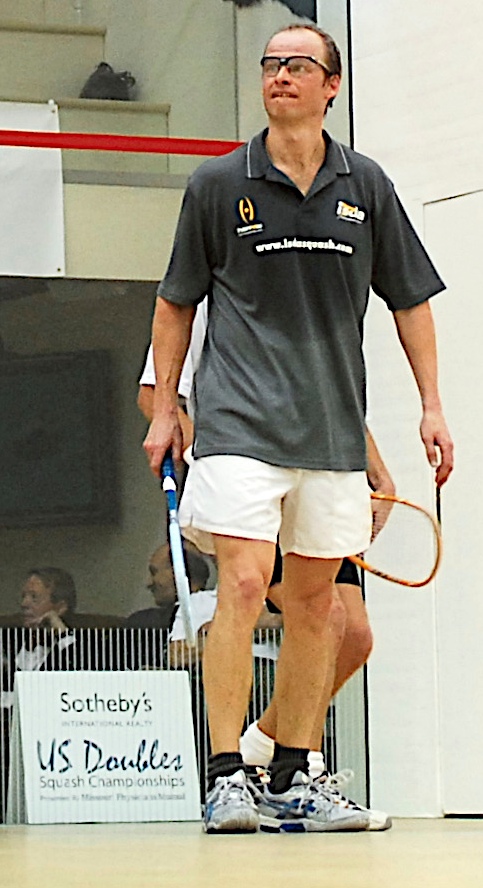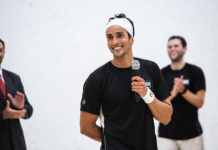By Gary Waite
For those of you who have played the game of Hardball Doubles, you will agree that it is a great game. It is a game many assumed would “expire” as its singles counterpart has to a large degree. However, the Hardball Doubles game has survived, and continued to grow, purely on its own merit. It is a version of our sport that is perhaps more friendly to the body, but also can be played at such speed as to fascinate even the most die-hard softball fan.
There is an established Professional Men’s Tour (ISDA), a growing Women’s Tour (WDSA) and a burgeoning number of club pros who have made their names from the former. The game now has momentum. In fact, within certain corridors of the squash community at large, there is a real “movement” afoot. Club events are bursting at the seams and permutations of combined age, family and sibling events are being worked and reworked nine ways to Sunday. We have all the ingredients for a successful venture here. We have enthusiasm, passion, financial wherewithal and places to play. What we lack is a competitive or developmental infrastructure amongst the demographic we would need to ensure the game’s survival. There are plenty of Open Divisions and age groups but few college or junior tournaments to speak of.

Part of the challenge for this group is access to the doubles court, and it is a primary goal of the Elmaleh Project to drive the demand in existing courts in order to build more courts. Among the most immediate concern is the lack of focus on the Under 25 playing population. One only has to look at the year’s schedule to realize that there are ample events available but unless you are playing on the ISDA or WDSA tours, as a 23-year-old fresh out of college you have very little opportunity to test your mettle against others like you. This is what the junior competitions are all about, and just like the juniors, the U25 crowd would bring an energy to the courts week-in and week-out that we do not have right now.
This is where the Partnership between Victor Elmaleh and U.S. SQUASH come in. The Elmaleh Project’s mandate is to build on the U.S. SQUASH Doubles Committee’s efforts to enhance the infrastructure for future support of the game among the U25 playing population. To date we have focused on the colleges and increasing participation in the National Intercollegiate Doubles Championships at the University Club of New York (Dec. 27-29), and the National Junior Doubles Championships at the Wilmington Country Club (Mar. 30, 2009) and establishing a National U25 Championship at the Greenwich Field Club (Apr. 24-26, 2009). We are working towards a support event sometime in March for the U25 crowd and a follow-up junior event at the Heights Casino in mid-April. There are other initiatives that are less progressed, but all in sync with fleshing out U25 and Junior activity with an eye towards having rankings in those categories established by the end of the season and for the following year. Our goal of National Championships at the U25, Intercollegiate and junior levels with 3 supporting events for each is not necessarily a lofty one but will require a concerted and cohesive effort which begs the question: Do we want to do this?
We have the clubs, the courts and the organizational fortitude as is evidenced by the plethora of squash events we now coordinate. If we apply the same abilities and will to doubles we will ensure the game’s survival. If we do not address this now and directly the game could well lose its momentum and be relegated to pasture.
The Elmaleh Project is a call to arms. For me it has been a wake-up call. Immersed in the hype of the ISDA these last eight years my enthusiasm for the sport was only embellished by accounts of growing club doubles championships and a burgeoning amateur scene. But once I began to scrutinize the entire landscape I suddenly realized, with a sense of dread, that the infrastructure void was so complete that the eventual demise of the game seemed inevitable. So, as a group, we have to decide to do this, to run junior doubles events, to run U25 events and to push for more courts. We need to all be partners in this venture. We need to deploy U.S. SQUASH’s expertise and infrastructure, we need the clubs and pros to be on board and, most vital, we, as a collective group of advocates for this great game, need to get young people on the courts. Ultimately, our success will be contingent on activity at the club level. There is no better way to grow a game than to get young people hooked. But in the end, it is up to you at the clubs who love the game and are familiar with how to run an event. So the question remains, do we want to do this?
Either way, we owe Victor, who will be 90 by the time this article goes to print, a show of gratitude for his enthusiasm and passion in initiating this project and giving this great game the attention it needs at such a crucial time. He has been a man of vision in his business dealings and is intent on giving flight to his passions in sports and the arts. It is his kind of commitment and vision to which we need to aspire. If we are able, I believe that we will all, with the possible exception of Victor, surprise ourselves with the result.





